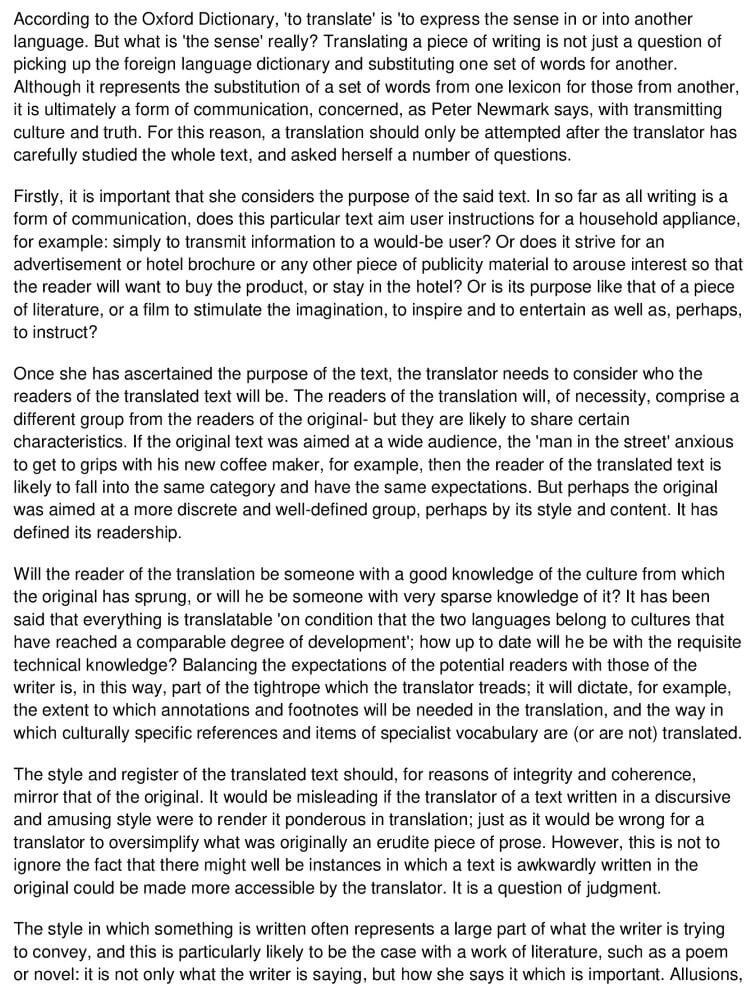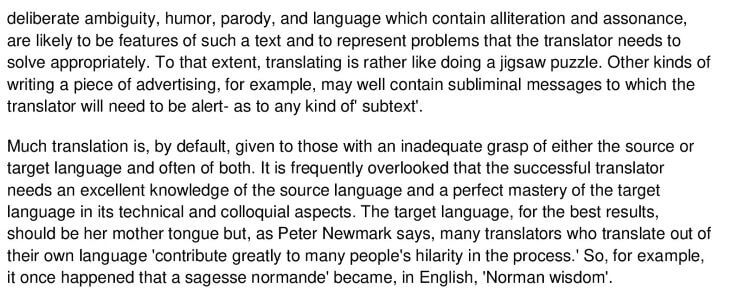Translation: From The Sublime To The Ridiculous?- IELTS Reading Answer
7 min read
Updated On
-
Copy link
Table of Contents

Limited-Time Offer : Access a FREE 10-Day IELTS Study Plan!
The Reading Module of the IELTS can be the top scoring category, with diligent practice. To achieve the best results in this section, you must understand how to approach and answer the different Question types in the Reading Module. By solving and reviewing Sample Reading Questions from past IELTS papers, you can ensure that your Reading skills are up to the mark.
Reading Passage
Translation: From The Sublime To The Ridiculous?


Question 1 – 3
1 Translating a text is more than merely
__________________ for others.
2 Each text whether informative, stimulating or instructive has ___________ that the translator needs to take into account.
3 The reader of the translation may have only a ________________ knowledge of the culture from which the original comes.
Question 4- 6
Choose the appropriate letters
A – D and write them in Boxes 4 – 6 on your answer sheet.
4 Anything can be translated, provided that…
- the two languages are equally developed.
- the two languages have similar levels of cultural development.
- the translator is up-to-date.
- the translator has the same expectations as the reader.
5 According to the writer, it is sometimes possible to make a translation …
- clearer than the original.
- overly simple.
- humorous.
- ponderous.
6 When translating a literary text, which one of the following is important for the translator?
- The way in which a writer says something as much as the content.
- Subliminal messages.
- Allusions.
- Jigsaw puzzles in texts.
Question 7 – 10
7.________
8.________
9 ________
10 ________
List of Judgements
A Weighing up why a writer says what she says.
B Determining the importance of poetry.
C Making a decision as to how far to stick to the original.
D Judging who the target audience of a translation will be.
E Whether translating is best done from the mother tongue.
F Deciding how many explanations, footnotes, and comments on vocabulary to
include.
G Deciding on which information to use from dictionaries.
H Whether to oversimplify a text.
Question 11 – 14
11 Translation is a form of communication; what does it, in essence, transmit?
12 What do readers of a translation and readers of the original text often share?
13 Which aspects of the translated text should reflect the original?
Reading Answer
1 Answer: substitute (some) words
Question type: Sentence Completion
Answer location: Paragraph 1, line 2
Answer explanation: The 2nd line of the first paragraph state that translating a piece of writing is not just a question of picking up a foreign language dictionary and substituting one set of words for another. These lines suggest that translating a text is more than merely substituting (some) words for others. Thus, the answer is to substitute (some) words.
2 Answer: A purpose
Question type: Sentence Completion
Answer location: Paragraph 2,last line
Answer explanation: The last line of the 2nd paragraph illustrates its purpose like that of a piece of literature or a film to stimulate the imagination, to inspire and to entertain as well as, perhaps, to instruct? We can deduce from these lines that each text, whether informative, stimulating or instructive, has a purpose that the translator needs to take into account. Thus, the answer is a purpose.
3 Answer: (very) sparse
Question type: Sentence Completion
Answer location: Paragraph 4
Answer explanation: In the 4th paragraph, it is stated, “will the reader of the translation be someone with a good knowledge of the culture from which the original has sprung, or will he be someone with a very sparse knowledge of it.” Thus, it is clear from these lines that the reader of the translation may have only a (very) sparse knowledge of the culture from which the original comes. Hence, the answer is (very) sparse.
4 Answer: B
Question type: Multiple Choice Question
Answer location: Paragraph 4
Answer explanation: In paragraph 4, it is stated that everything is translatable ‘on condition that the two languages belong to cultures that have reached a comparable degree of development.’ We can deduce from these lines that anything can be translated, provided that the two languages have similar levels of cultural development. Hence, the answer is B.
5 Answer: A
Question type: Multiple Choice Question
Answer location: Paragraph 5, last line
Answer explanation: Paragraph 5, the last line suggests that however, this is not to ignore the fact that there might well be instances in which a text is awkwardly written in the original could be made more accessible by the translator. It is a question of judgment. We can deduce from these lines that according to the writer, it is sometimes possible to make a translation clearer than the original. Hence, the answer is A.
6 Answer: A
Question type: Multiple Choice Question
Answer location: Paragraph 3
Answer explanation: Paragraph 3 illustrates that once she has ascertained the purpose of the text, the translator needs to consider who the readers of the translated text will be. The readers of the translation will, of necessity, comprise a different group from the readers of the original- but they are likely to share certain characteristics. If the original text was aimed at a wide audience, the ‘man in the street’ anxious to get to grips with his new coffee maker, for example, then the reader of the translated text is likely to fall into the same category and have the same expectations. But perhaps the original was aimed at a more discrete and well-defined group, perhaps by its style and content. It has defined its readership. These lines indicate that when translating a literary text, the way in which a writer says something as much as the content is important for the translator. Thus, the answer is A.
7 Answer: A
Question type: Matching Features
Answer location: Paragraph 5
Answer explanation: In paragraph 5, it is mentioned that the style in which something is written often represents a large part of what the writer is trying to convey, and this is particularly likely to be the case with a work of literature, such as a poem or novel: it is not only what the writer is saying, but how she says it which is important. We can understand from these lines that weighing up why a writer says what she says. Thus, the answer is A.
8 Answer: C
Question type: Matching Features
Answer location: Paragraph 3, last line
Answer explanation: The last line of 3rd Paragraph state that if the original text was aimed at a wide audience, the ‘man in the street’ anxious to get to grips with his new coffee maker, for example, then the reader of the translated text is likely to fall into the same category and have the same expectations. But perhaps the original was aimed at a more discrete and well-defined group, perhaps by its style and content. It has defined its readership. These lines suggest making a decision as to how far to stick to the original. Hence, the answer is C.
9 Answer: D
Question type: Matching Features
Answer location: Paragraph 5
Answer explanation: In the 5th Paragraph, It is mentioned that however, this is not to ignore the fact that there might well be instances in which a text is awkwardly written in the original could be made more accessible by the translator. It is a question of judgment. These lines indicate Judging who the target audience of a translation will be. Thus, the answer is D.
10 Answer: F
Question type: Matching Features
Answer location: Paragraph 4, last line
Answer explanation: The last line of the 4th Paragraph states that Balancing the expectations of the potential readers with those of the writer is, in this way, part of the tightrope which the translator treads; it will dictate, for example, the extent to which annotations and footnotes will be needed in the translation, and the way in which culturally specific references and items of specialist vocabulary are (or are not) translated. These lines indicate deciding how many explanations, footnotes, and comments on vocabulary to
include. Thus, the answer is F.
11 Answer: culture and truth
Question type: Short Answer Questions
Answer location: Paragraph 1
Answer explanation: Paragraph 1 states that although it represents the substitution of a set of words from one lexicon for those from another, it is ultimately a form of communication, concerned, as Peter Newmark says, with transmitting culture and truth. We can deduce from these lines that translation is a form of communication; and culture and truth are in essence, transmit. Hence, the answer is Culture and truth.
12 Answer: certain characteristics/ the same expectations
Question type: Short Answer Questions
Answer location: Paragraph 3
Answer explanation: Paragraph 3 states that the readers of the translation will, of necessity, comprise a different group from the readers of the original- but they are likely to share certain characteristics. If the original text was aimed at a wide audience, the ‘man in the street’ anxious to get to grips with his new coffee maker, for example, then the reader of the translated text is likely to fall into the same category and have the same expectations. These lines suggest that the certain characteristics/ aspects of the translated text should reflect the original. Hence, the answer is certain characteristics/ the same expectations.
13 Answer: style and register
Question type: Short Answer Questions
Answer location: Paragraph 5
Answer explanation: The initial lines of paragraph 5 states that the style and register of the translated text should, for reasons of integrity and coherence, mirror that of the original. We can deduce from these lines that according to the text, the translator must look at the style and register carefully before trying to do a translation. Thus, the answer is style and register.
Check More IELTS Reading Answers
Practice IELTS Reading based on question types

Start Preparing for IELTS: Get Your 10-Day Study Plan Today!
Recent Articles

Nehasri Ravishenbagam

Haniya Yashfeen

Haniya Yashfeen

Haniya Yashfeen




Post your Comments